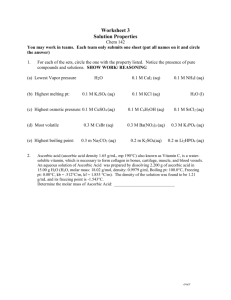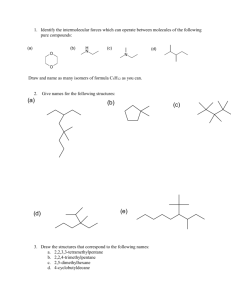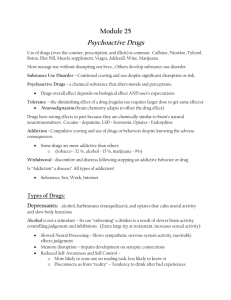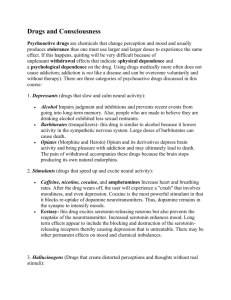Analysis of Dopamine Using Rotating Disk Voltammetry
advertisement
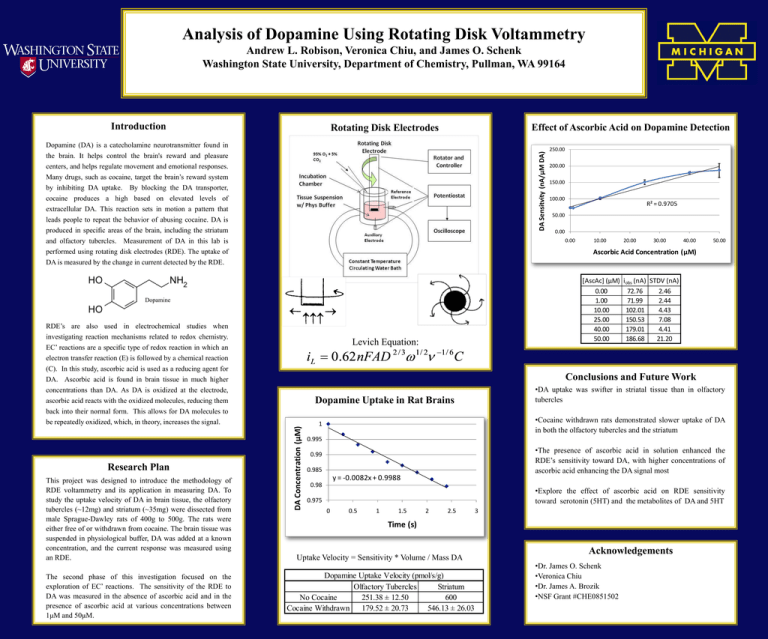
Analysis of Dopamine Using Rotating Disk Voltammetry Andrew L. Robison, Veronica Chiu, and James O. Schenk Washington State University, Department of Chemistry, Pullman, WA 99164 Introduction Effect of Ascorbic Acid on Dopamine Detection Rotating Disk Electrodes DA Sensitvity (nA/μM DA) Dopamine (DA) is a catecholamine neurotransmitter found in the brain. It helps control the brain's reward and pleasure centers, and helps regulate movement and emotional responses. Many drugs, such as cocaine, target the brain’s reward system by inhibiting DA uptake. By blocking the DA transporter, cocaine produces a high based on elevated levels of extracellular DA. This reaction sets in motion a pattern that leads people to repeat the behavior of abusing cocaine. DA is produced in specific areas of the brain, including the striatum and olfactory tubercles. Measurement of DA in this lab is performed using rotating disk electrodes (RDE). The uptake of DA is measured by the change in current detected by the RDE. The second phase of this investigation focused on the exploration of EC’ reactions. The sensitivity of the RDE to DA was measured in the absence of ascorbic acid and in the presence of ascorbic acid at various concentrations between 1μM and 50μM. 150.00 100.00 R² = 0.9705 50.00 0.00 10.00 20.00 30.00 40.00 50.00 Ascorbic Acid Concentration (μM) RDE’s are also used in electrochemical studies when investigating reaction mechanisms related to redox chemistry. EC’ reactions are a specific type of redox reaction in which an electron transfer reaction (E) is followed by a chemical reaction (C). In this study, ascorbic acid is used as a reducing agent for DA. Ascorbic acid is found in brain tissue in much higher concentrations than DA. As DA is oxidized at the electrode, ascorbic acid reacts with the oxidized molecules, reducing them back into their normal form. This allows for DA molecules to be repeatedly oxidized, which, in theory, increases the signal. *AscAc+ (μM) 0.00 1.00 10.00 25.00 40.00 50.00 Levich Equation: i obs (nA) STDV (nA) 72.76 2.46 71.99 2.44 102.01 4.43 150.53 7.08 179.01 4.41 186.68 21.20 Conclusions and Future Work •DA uptake was swifter in striatal tissue than in olfactory tubercles Dopamine Uptake in Rat Brains DA Concentration (μM) This project was designed to introduce the methodology of RDE voltammetry and its application in measuring DA. To study the uptake velocity of DA in brain tissue, the olfactory tubercles (~12mg) and striatum (~35mg) were dissected from male Sprague-Dawley rats of 400g to 500g. The rats were either free of or withdrawn from cocaine. The brain tissue was suspended in physiological buffer, DA was added at a known concentration, and the current response was measured using an RDE. 200.00 0.00 Dopamine Research Plan 250.00 •Cocaine withdrawn rats demonstrated slower uptake of DA in both the olfactory tubercles and the striatum 1 0.995 •The presence of ascorbic acid in solution enhanced the RDE’s sensitivity toward DA, with higher concentrations of ascorbic acid enhancing the DA signal most 0.99 0.985 y = -0.0082x + 0.9988 0.98 •Explore the effect of ascorbic acid on RDE sensitivity toward serotonin (5HT) and the metabolites of DA and 5HT 0.975 0 0.5 1 1.5 2 2.5 3 Time (s) Uptake Velocity = Sensitivity * Volume / Mass DA Dopamine Uptake Velocity (pmol/s/g) Olfactory Tubercles Striatum No Cocaine 251.38 ± 12.50 600 Cocaine Withdrawn 179.52 ± 20.73 546.13 ± 26.03 Acknowledgements •Dr. James O. Schenk •Veronica Chiu •Dr. James A. Brozik •NSF Grant #CHE0851502
